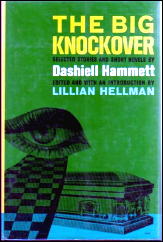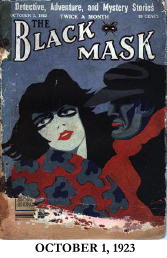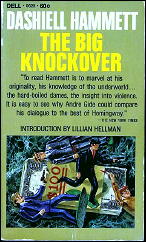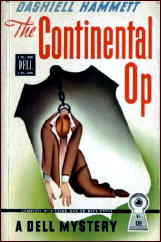Thu 17 Sep 2009
A 1001 MIDNIGHTS review: DASHIELL HAMMETT – The Big Knockover (1966).
Posted by Steve under 1001 Midnights , Pulp Fiction , Reviews[12] Comments
by Bill Pronzini:
DASHIELL HAMMETT – The Big Knockover. Edited and with an Introduction by Lillian Hellman. Random House, 1966. Paperback reprint: Dell, 1967, in two volumes: The Big Knockover and The Continental Op: More Stories from The Big Knockover. Also: Vintage V829, 1972.
Samuel Dashiell Hammett was the father of the American “hard-boiled” or realistic school of crime fiction.

As Raymond Chandler says in his famous essay “The Simple Art of Murder,” Hammett “wrote at first (and almost to the end) for people with a sharp, aggressive attitude to life. They were not afraid of the seamy side of things; they lived there. Violence did not dismay them; it was right down their street. Hammett gave murder back to the kind of people that commit it for reasons, not just to provide a corpse; and with the means at hand, not hand-wrought dueling pistols, curare and tropical fish. He put these people down on paper as they were, and he made them talk and think in the language they customarily used for these purposes.”
Hammett’s first published short story, “The Road Home,” appeared in the December 1922 issue of the pioneering pulp magazine Black Mask under the pseudonym Peter Collinson. The first “Continental Op” story was “Arson Plus,” also published as by Collinson, in the October 1, 1923, issue; the October 15 number contained “Crooked Souls,” another Op novelette and Hammett’s first appearance in the magazine under his own name. (“Arson Plus” was not the first fully realized hard-boiled private-eye story; that distinction belongs to “Knights of the Open Palm,” by Carroll John Daly, which predated the Op’s debut by four months, appearing in the June 1, 1923, issue of Black Mask.)

Two dozen Op stories followed over the ensuing eight years; the series ended with “Death and Company” in the November 1930 issue.
The Op — fat, fortyish, and the Continental Detective Agency’s toughest and shrewdest investigator — was based on a man named James Wright, assistant superintendent of the Pinkerton Detective Agency in Baltimore, for whom Hammett had worked. And his methods, if not his cases, are based on real private-investigative procedures of the period.
It was in these Op stories that Hammett honed his realistic style and plotting techniques, both of which would reach their zenith in The Maltese Falcon (1929).

The Big Knockover contains thirteen of the best Op stories, among them such hard-boiled classics as “The Gutting of Couffignal,” about an attempted hoodlum takeover of an island in San Francisco Bay, during which corpses pile up in alarming numbers and a terrific atmosphere of menace and suspense is maintained throughout; “Dead Yellow Women,” which has a San Francisco Chinatown setting and colorfully if unfortunately perpetuates the myth that a rabbit warren of secret passageways exists beneath the streets of that district; “Fly Paper,” in which the Op undertakes “a wandering daughter job,” with startling results; “Corkscrew,” a case that takes the Op to the Arizona desert in an expert blend of the detective story and the western; and “$106,000 Blood Money,” a novella in which the Op sets out to find the gang that robbed the Seaman’s National Bank of several million dollars, and does battle with perhaps his most ruthless antagonist.

Lillian Hellman’s introduction provides some interesting but manipulated and self-serving material on Hammett and his work.
This is a cornerstone book for any library of American detective fiction, and an absolute must-read for anyone interested in the origins of the hard-boiled crime story.
The Continental Op appears in several other collections, most of which were edited by Ellery Queen and published first in digest-size paperbacks by Jonathan Press and then in standard paperbacks by Dell; among these are The Continental Op (1945), The Return of the Continental Op (1945), Hammett Homicides (1946), Dead Yellow Women (1947), Nightmare Town (1948), The Creeping Siamese (1950), and Woman in the Dark (1951).
The most recent volume of Op stories, The Continental Op, a companion volume to The Big Knockover but edited and introduced by Stephen Marcus instead of Hellman, appeared in 1974.
———
Reprinted with permission from 1001 Midnights, edited by Bill Pronzini & Marcia Muller and published by The Battered Silicon Dispatch Box, 2007. Copyright © 1986, 2007 by the Pronzini-Muller Family Trust.
Editorial Comment: Coming over the four days, spread out at a rate of one a day, will be reviews by Bill Pronzini and Mike Nevins of The Dain Curse, The Glass Key, The Maltese Falcon, and The Thin Man, all taken from 1001 Midnights.
September 17th, 2009 at 11:39 am
This was the first book I ever purchased in hardcover at the full publisher’s price. Before that my collection consisted only of paperbacks, used books, and book club editions. How did I justify spending so much money at a time when I was just married and still in grad school?
You don’t really have to ask, do you?
September 17th, 2009 at 2:25 pm
This was the first hardcover I ever bought for myself too — at least at full price from a bookstore (in fact there is still a book mark from Taylors in Dallas in it somewhere). Seemed really extravagant paying $7.95 for a book.
It was a treasure trove for me since save for the novels it wasn’t that easy to find Hammett’s previous collections in a small town in North Texas.
And I still don’t know why no one has done a single edition of all the Op stories. Luckily I’ve caught up with most of Hammett’s published and some unpublished short fiction over the years, but it took much more effort than any other major writer in the genre I can think of.
September 17th, 2009 at 3:31 pm
There was also a Jonathan Press digest titled “The Big Knockover” – a reprint of the Bestseller Mystery digest “$106,000 Blood Money.”
I must agree with David. It’s both amazing and sad that all the Op stories have yet to be collected in one or more volumes.
September 17th, 2009 at 3:40 pm
Sorry, I didn’t buy THE BIG KNOCKOVER because I’d already scarfed up all those stories in the Dell editions I got at that depraved bookstore mentioned in an earlier post.
September 17th, 2009 at 3:54 pm
I don’t believe I have all the digest collections from Jonathan Press and so on, even today, though I did pick up a couple from Walter Albert at this year’s PulpFest. Back in ’66, when I bought the hardcover collection, I’m not sure if I had all the Dell’s or not.
But I don’t think so. I don’t think I found those until I moved to CT in ’69. I don’t even think I knew they existed in 1966. Those Dell books are gems.
September 17th, 2009 at 4:01 pm
The Dell’s are gems, but so delicate I hate to open them. I haven’t looked at the prices recently, but they used to be pretty steep for paperbacks.
September 17th, 2009 at 7:44 pm
I was looking for an OP collection last year and was surprised too to see there was no definitive, complete one.
September 18th, 2009 at 11:14 am
I think you people have just convinced me that I should read this collection in its entirety — even though there are several other books on my current “to be read” stack. Maybe I’ll take my copy with me when I have my usual Friday lunch at the Tavern today.
September 18th, 2009 at 12:41 pm
Maybe I’ll drive over and join you for one of those Friday lunches, Randy. If I were to leave here on a Wednesday, I might get there in time — if I didn’t stop to sleep along the way.
In any case, enjoy the book!
September 19th, 2009 at 3:34 pm
I, for one, would certainly snap up a definitive edition of the Op stories, especially if it included a good study of them and presented them in chronological order. The best stories are fairly easy to find, but I don’t see why they haven’t been collected the way Chandler’s complete short stories have.
The trouble with the Op collections that are out there is they tend to include the same stories with only minor exceptions. I understood when Hellman was alive that she kept a lot of what she considered lesser Hammett out of print, but she’s been gone quite a while and I know there would be a market for a one or two volume collection of all the Op stories, the two novellas, and the two novels.
There is a good deal more variety as to setting and plot to the Op stories than you might expect (the Op not only goes out West, but ends up an revolution in one story), and with a writer as major as Hammett it’s hard to imagine why no one has tackled such a project. Several recent collections have included rare Hammett stories, but you know there is a market for the Op tales in handy and complete edition.
September 21st, 2009 at 1:31 pm
Just in case anyone wondered what happened when I started The Big Knockover over lunch last Friday … I finished the book in the wee hours this morning and am planning to read the Steven Marcus edition of The Continental Op (1974) and then follow that by reading the stories in the nine digest collections or Dell paperbacks (edited by Ellery Queen) that don’t appear in either The Big Knockover or The Continental Op. (The only title I don’t have in the “collected edition” is Woman in the Dark, but I have most of the stories in other sources … I haven’t checked abebooks to see what copies are going for.)
Exciting stuff though I kept losing track of who was who and what was happening as well as marveling at the dialogue. Hard to believe some of these stories are 80 or 90 years old!
Chandler’s short stories and novels were made available in two volumes from Hamish Hamilton and the novels in two more, but where is the definitve Hammett? Does anyone know the fate of a project edited by Vince Emery of San Francisco that began in 2005 with a stout collection called Dashiell Hammett: Lost Stories?
Now let’s go see what others are saying on this blog about Hammett’s novels!
September 22nd, 2009 at 8:33 pm
Woman in the Dark is not an Op story (I couldn’t tell if you thought it was or were merely commenting on it’s not being in any of the omnibus editions of the novels), but a short novel Hammett wrote for a film that starred Ralph Bellamy as an artist who gets involved with a girl on the run. I think it may also have run in one of the slicks of the era. The film was available on VHS and the book should be easy to find on the Net. Minor Hammett, but worth reading.
There is also a lost Hammett film, Rouben Mamoulian’s City Streets (1931) with Gary Cooper and Sylvia Sidney based on Hammett’s screen story.